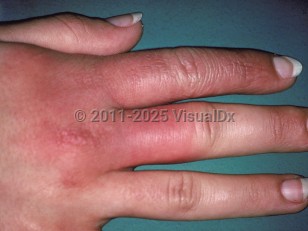Erysipeloid
See also in: Cellulitis DDxSynopsis

Erysipeloid is characterized by erythematous to violaceous well-defined plaques with edema and raised borders. Vesicles, bullae, and erosions can also be present. The lesions of erysipeloid are generally located on the back of the hands and/or fingers. They are most often asymptomatic, but some patients may report mild pain, pruritus, or fever.
The diffuse / generalized form is rare and is characterized by similar cutaneous lesions in a widespread distribution. Unlike localized erysipeloid, patients with the diffuse / generalized form often report fever, lymphadenitis, and arthralgias.
In addition to the localized and diffuse cutaneous disease detailed above, the bacterium can also cause systemic disease, most often in the form of acute or subacute endocarditis. Endocarditis is rare and usually affects previously damaged valves.
The lesions of localized cutaneous erysipeloid often resolve without treatment in 3-4 weeks but may recur. Therefore, treatment with antibiotics is indicated in all forms of erysipeloid.
Codes
A26.0 – Cutaneous erysipeloid
SNOMEDCT:
400105005 – Erysipeloid
Look For
Subscription Required
Diagnostic Pearls
Subscription Required
Differential Diagnosis & Pitfalls

Subscription Required
Best Tests
Subscription Required
Management Pearls
Subscription Required
Therapy
Subscription Required
References
Subscription Required
Last Updated:06/18/2018


